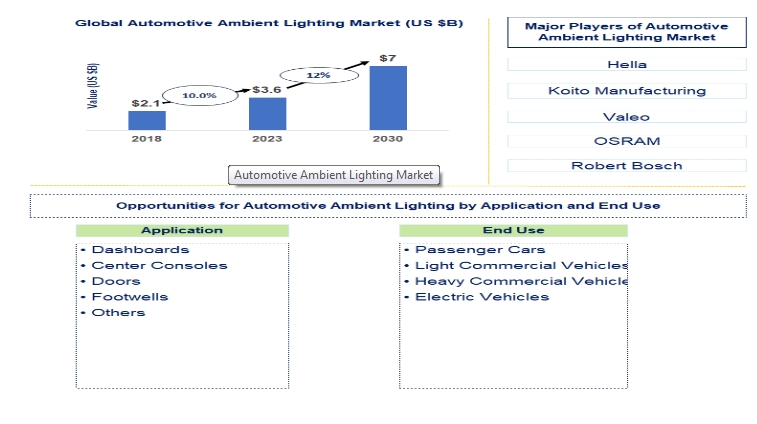
“Cisco Systems Inc. (US), Qualcomm Technologies Inc. (US), Broadcom Inc (US), Intel Corporation (US), Huawei technologies (China), NETGEAR Inc (US), Juniper Networks Inc (US), Extreme Networks Inc. (US), Ubiquiti Inc. (US), Fortinet Inc. (US), Aruba Networks (US).”
Wi-Fi 6 Market by Offering (Hardware, Solution, and Services), Location Type, Application (Immersive Technologies, IoT & Industry 4.0, Telemedicine), Vertical (Education, Media & Entertainment, Retail & eCommerce) and Region – Global Forecast to 2028.
The global Wi-Fi 6 market is projected to grow significantly, expanding from USD 5.7 billion in 2023 to USD 20.9 billion by 2028, at an impressive Compound Annual Growth Rate (CAGR) of 29.3%. The rising number of internet users is a key driver of this growth, fueling demand for Wi-Fi 6 and its associated services. Additionally, the rapid increase in connected devices and data-intensive applications in business environments has amplified the need for higher data speeds and enhanced network capacity. Wi-Fi 6 addresses these demands by delivering superior performance and efficiency, making it a critical solution for meeting the evolving requirements of modern connectivity.
Download PDF Brochure@ https://www.marketsandmarkets.com/pdfdownloadNew.asp?id=174384441
By Application, HD video streaming and video conferencing segment is estimated to account for the largest market share in 2023.
Wi-Fi 6 is used in video streaming to deliver video content to users over the internet. Wireless technology allows devices to communicate with each other without the need for a physical connection. Wi-Fi is a wireless technology that uses radio waves to transmit data. Wi-Fi 6 is essential for video streaming because it enables users to watch video content on any device with an internet connection. This includes smartphones, tablets, laptops, and smart TVs.
By Hardware, system on chip is expected to register the fastest growth rate during the forecast period.
A Wi-Fi System-on-Chip is a single chip that integrates all the necessary components for a Wi-Fi device. This includes the Wi-Fi radio, processor, memory, and other components. Wi-Fi SoCs enable a more compact and efficient design and improved performance and power efficiency. They are used in a variety of devices, such as smartphones, tablets, laptops, and smart home devices.
Asia Pacific is expected to have the highest growth rate
Businesses in the Asia Pacific region, particularly in industries like IT, telecom, retail, and healthcare, are showing strong optimism and awareness about the benefits of Wi-Fi 6. This positive attitude contributes to the region’s growth of the Wi-Fi 6 industry, with more commercial clients adopting reliable Wi-Fi 6 solutions and services. The advancements in technology in the Asia Pacific region, combined with the increasing trend of using Wi-Fi solutions, are expected to bring further benefits to the Wi-Fi market. Several countries in the region, including China, Japan, South Korea, and Australia, have designated a spectrum for Wi-Fi 6 use, enabling wireless service providers to offer faster speeds and better performance to their customers by rolling out Wi-Fi 6 networks.
Request Sample Pages@ https://www.marketsandmarkets.com/requestsampleNew.asp?id=174384441
Unique Features in the Wi-Fi 6 Market
Wi-Fi 6 offers significant improvements in speed and capacity compared to previous generations. With speeds reaching up to 9.6 Gbps, it is capable of handling more data at faster rates, ensuring smooth and uninterrupted connectivity even in high-density environments. This makes it ideal for both home users and business settings where high-speed internet is essential for various applications, including streaming, gaming, and enterprise operations.
Wi-Fi 6 introduces OFDMA, which allows multiple devices to communicate simultaneously on a single channel. This technology reduces congestion and improves network efficiency, especially in areas with many connected devices, such as stadiums, airports, and office buildings. By dividing channels into smaller sub-channels, it maximizes the network’s ability to handle multiple users and devices without compromising performance.
Wi-Fi 6 is designed to offer improved coverage and range. The technology uses advanced signal encoding and modulation techniques to boost signal strength and extend Wi-Fi coverage, even in larger or multi-floor buildings. This ensures consistent and reliable connections for users across a broader area, which is particularly beneficial for enterprises with large spaces or those in rural areas.
Wi-Fi 6 includes WPA3, the latest security protocol, providing more robust encryption for users’ data. WPA3 offers stronger protection against brute-force attacks and improves security for devices that may have previously been vulnerable. This is especially important for businesses handling sensitive data, ensuring that the network is secure and that user privacy is maintained.
Wi-Fi 6 is specifically designed to perform better in high-density environments, where numerous devices are connected to the same network. This includes settings like concert venues, conference halls, and crowded public areas. Wi-Fi 6 helps manage large volumes of traffic, ensuring each device gets an optimal amount of bandwidth and reducing network congestion.
Major Highlights of the Wi-Fi 6 Market
The global Wi-Fi 6 market is experiencing rapid growth, driven by the increasing demand for faster internet speeds, higher network capacity, and the proliferation of connected devices. As businesses and consumers seek more reliable and efficient connectivity, the adoption of Wi-Fi 6 is expanding, with projections indicating significant market growth over the next few years. The transition from older Wi-Fi standards to Wi-Fi 6 is gaining momentum across various industries, including enterprise, retail, healthcare, and education.
With the growing use of data-intensive applications such as 4K/8K streaming, gaming, augmented and virtual reality (AR/VR), and IoT devices, the demand for faster and more reliable wireless connections is surging. Wi-Fi 6 addresses these needs by offering enhanced speeds, better performance in high-density environments, and the ability to handle multiple devices simultaneously without compromising speed or quality. This makes Wi-Fi 6 an essential technology for both home users and businesses looking to keep up with the evolving digital landscape.
Wi-Fi 6 is becoming the preferred solution for high-density environments like stadiums, airports, offices, and smart cities. With features such as Orthogonal Frequency-Division Multiple Access (OFDMA) and improved channel efficiency, Wi-Fi 6 enables stable and high-performance connectivity even in spaces where large numbers of devices are connected to the same network. This capacity for better performance in crowded settings is one of the key factors driving Wi-Fi 6 adoption in both public and private sectors.
The integration of WPA3 security protocol in Wi-Fi 6 ensures stronger encryption and better protection against cyber threats. With the rise in cyberattacks and data breaches, businesses are increasingly prioritizing secure network infrastructure, and Wi-Fi 6’s enhanced security features make it an attractive choice. WPA3 ensures that devices connected to the network are less vulnerable to hacking attempts, protecting sensitive data and improving user privacy.
Inquire Before Buying@ https://www.marketsandmarkets.com/Enquiry_Before_BuyingNew.asp?id=174384441
Top Companies in the Wi-Fi 6 Market
The major vendors covered in the Wi-Fi 6 market include Cisco Systems Inc. (US), Qualcomm Technologies Inc. (US), Broadcom Inc (US), Intel Corporation (US), Huawei technologies (China), NETGEAR Inc (US), Juniper Networks Inc (US), Extreme Networks Inc. (US), Ubiquiti Inc. (US), Fortinet Inc. (US), Aruba Networks (US), NXP Semiconductors (Netherlands), AT&T (US), D–Link Corporation (Taiwan), Alcatel Lucent Enterprise (France), TP–Link Corporation Limited (China), MediaTek Inc. (Taiwan), Telstra (Australia), Murata Manufacturing Co., Ltd. (Japan), Sterlite Technologies Limited (India), Renesas Electronics (Japan), H3C Technologies Co., Ltd. (China), Keysight Technologies (US), LitePoint (US), Rohde & Schwarz (Germany), Cambium Networks, Ltd. (US), Senscomm Semiconductors Co., Ltd. (China), XUNISON (Ireland), Redway Networks Ltd. Company (England), VSORA SAS (France), WILUS Inc. (South Korea), Federated Wireless, Inc. (US), Actiontec Electronics (US), ADB Global (Switzerland), SDMC Technology (China), and Edgewater Wireless (Canada).
Cisco
Cisco specializes in designing and selling a broad range of technologies that power the internet. The company offers its products and technologies into the following categories: secure, agile networks; internet for the future; collaboration; end-to-end security; optimized application experiences; and other products. Also, it provides a broad range of service offerings, consisting of technical support and advanced services. It provides services to businesses of all sizes, public institutions, governments, and service providers, including large web-scale providers. The company also provides comprehensive advisory services focused on responsive, preventive, and consultative support of technologies for specific networking needs. It also offers support and maintenance services to help the customers ensure their products operate efficiently, remain available, and benefit from the most up-to-date system and application software. The services offered by the company help customers to protect their network investments, manage risk, and minimize downtime for systems running mission-critical applications. Cisco Meraki offers cloud-managed wireless solutions and services as its products in the global Wi-Fi 6 market. The company’s customers primarily operate in the following markets: enterprise, commercial, service provider, and public sector. It conducts business globally and has a presence across the Americas, Europe, Middle East, and Africa (EMEA), and Asia Pacific, Japan, and China (APJC).
QUALCOMM
Qualcomm is a global leader in developing and commercializing foundational technologies for the wireless industry. The technologies and products are used in mobile devices and other wireless products. They are sold across industries and applications beyond mobile handsets, including automotive and the Internet of Things (IoT) (which includes the industries and applications of consumer, industrial, and edge networking). The company’s inventions have helped power the growth of smartphones, which have connected billions of people. Qualcomm is a leader in 3G (third generation), 4G (fourth generation), and 5G (fifth generation) wireless technologies. Most 5G devices include multimode support for 3G, 4G, and Wi-Fi 6 technologies, enabling service continuity. They also allow mobile operators to utilize existing 3G and 4G network infrastructure, enabling them to roll out 5G services over time while helping maximize previous-generation equipment investments.
Broadcom Inc. (US)
Broadcom Inc. is a global technology company headquartered in San Jose, California, that designs and supplies semiconductor and infrastructure software solutions. Founded in 1961, Broadcom’s products include semiconductor devices for data center networking, broadband, wireless communications, and infrastructure software. It is one of the largest semiconductor companies worldwide, known for innovations in Wi-Fi, Bluetooth, and broadband modems.
Media Contact
Company Name: MarketsandMarkets™ Research Private Ltd.
Contact Person: Mr. Rohan Salgarkar
Email: Send Email
Phone: 18886006441
Address:1615 South Congress Ave. Suite 103, Delray Beach, FL 33445
City: Florida
State: Florida
Country: United States
Website: https://www.marketsandmarkets.com/Market-Reports/wi-fi-6-market-174384441.html
Press Release Distributed by ABNewswire.com
To view the original version on ABNewswire visit: Wi-Fi 6 Market to Witness Notable Growth Analysis, Latest Trends, New Opportunities, and Industry Potential by 2028














